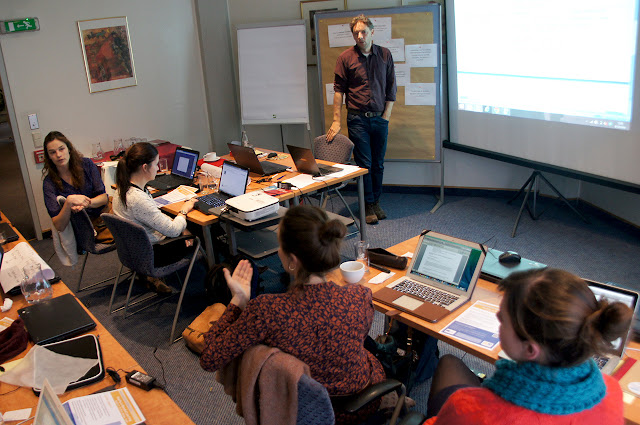Blended Learning is flexible, accessible and well-placed to
meet the diverse needs of various learners in different fields of education
(VET and Higher Education as well as in Adult Education). There exist several
documents[1]
dealing with the topic of learners needs focusing on distance education dated
to the first decade of the 21st century. Here basic considerations
are done covering aspects like motivation or experience, necessary feedback or
focus on practical work.
 |
| Blended Learning course: OnSite Teaching (from: Quality in Blended Learning Course, (c) Peter Mazohl) |
After these publications, there exist a kind of “radio
silence”. You will find publications about Distance learning courses and others
dealing with Blended Learning, but in almost none the focus is set to the
learner and the learners’ needs. What is also missing is the mentioning of the
necessary pedagogy in Distance Learning as well as in Blended Learning. That
goes hand in hand with the lack of qualified quality frameworks offering more
than the puristical ISO/IEC 19796 standard.
The Multilateral Grundtvig Project about “Quality in Blended
Learning” developed a list of typical needs of learners in Blended Learning
courses, out from several surveys combined with the experience of international
experts and the feedback from the biggest University based Blended Learning
project “AKMAT” (University of Technology Vienna).
Here is a short list in a quickly done overview mentioning
the most important learners’ needs. More information and a detailed report about
the project is available at the webpage of the consortium.
| Blended Learner isolated during the Distance Learning |
Learners want or need:
- Interest in topic (normally learners are interested in the course when they enrol
- Basic IT skill
- Requirements should be announced befor
- Enough time to be present at the classroom and to do the assignments in the distance learning phas
- Learners don’t want to feel lonely or left alone (as they are physically far from the place where the training is given and often are not well connected to their learning mates or peers
- High level of motivation to achieve training objective
- Learners must be very proactive (and have to be aware of it – often they have to learn this before participating at a Blended Learning course)
- The student must be continually informed on every detail, in order to do proper planning and be well adjusted to the course schedule
- Well
prepared and appropriate information during the course
o The student must comply with the deadlines for the delivery of work
o thee must comply with activities in the platform
o to have good results and not to accumulate work, which might cause anxiety and stress. - There should be monitoring of the questions raised and the work developed by the students.
- Quickly done feedback of assignments
- On-line support is essential, and should be constant and permanent.
- The quality of the manuals, the bibliography and the proper maintenance of the learning platform are of utmost importance
This is not
a complete list. Otherwise, it offers an impact. Please comment this article
and feel free to give us a feedback about your experience and your opinion to
the learners’ needs in Blended Learning!
[1] Leslie
A. Dare (ED): Assessing the needs of distance learners: A student affairs
perspective (http://onlinelibrary.wiley.com/doi/10.1002/ss.183/abstract)
or Linda Stilborne and Lindy Williams: Meeting the Needs of Adult
Learners in Developing Courses for the Internet (https://www.isoc.org/inet96/proceedings/c4/c4_2.htm).